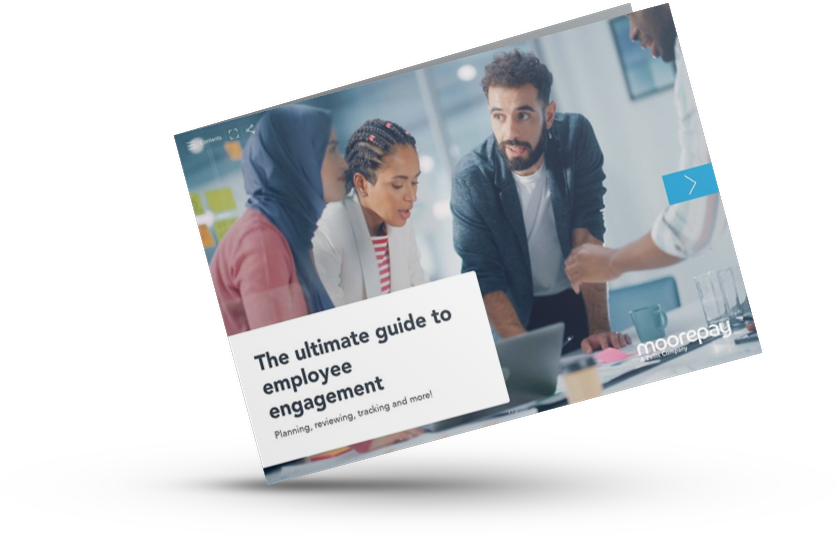Ultimate guide
Your ultimate guide to employee engagement

Contents
Go straight to the employee engagement topic you’re interested in by clicking on the text below.
-
Chapter 1
What is employee engagement?
-
Chapter 2
Why is employee engagement important?
-
Chapter 3
How do you measure employee engagement?
-
Chapter 4
How to boost employee engagement
-
Chapter 5
Employee engagement activities
-
Chapter 6
Why is your employee engagement low?
-
Chapter 7
Employee engagement and retention
-
Chapter 8
Our guide to employee engagement

Chapter 1
What is employee engagement?
In this chapter you’ll learn
- The definition of employee engagement
- Everything that's covered
A quick intro into engagement
Employee engagement is more than a buzzword in the world of HR. It’s about understanding what keeps your people motivated, satisfied, and aligned with company goals. It goes beyond your people just feeling happy in their role: engaged employees feel a sense of belonging and purpose.
So, what makes an engaged employee and why is it more important than ever?
Why is employee engagement so relevant?
For HR professionals, knowing the ins and outs of employee engagement is crucial. It’s the heartbeat of a successful company, linked to everything from productivity, to employee retention and beyond. You’ll find that measuring this engagement is key, and it’s not just about annual surveys anymore (although they’re still important)!
Today, there are a whole host of tools to help boost engagement. From software that offers real-time insights into how engaged our colleagues really are, to different activities that bring your workplace together. As the CIPD cites:

Employees who have good quality jobs and are managed well, will not only be happier, healthier and more fulfilled, but are also more likely to drive productivity, better products or services, and innovation.
Source: CIPD

Chapter 2
Why is employee engagement important?
In this chapter you’ll learn
- Why employee engagement is important
- The factors that affect engagement
- A brief summary
The benefits of increased engagement
Click on the arrows to learn more.
-
Increased productivity
When colleagues are engaged, they bring their best selves to work. It’s not just working harder, it’s about working smarter. Engaged employees are more likely to be innovative and find efficient ways to tackle their tasks. Studies have shown that employee engagement is directly linked to higher productivity levels. It’s simple: when your team cares about what they do, they do it better.
-
Higher job satisfaction
A higher workplace engagement will see a boost in job-satisfaction. Engaged employees that are fulfilled in their role, find meaning, and have pride in their work will see a high job satisfaction and therefore contribute to a healthy workplace atmosphere.
-
Reduced turnover
It’s plain and simple this one, an engaged workforce is less likely to leave their place of work. Reducing the cost of recruitment and training and maintaining an experienced team. There is a full section on retention here.
-
Better culture
Employee engagement is a cornerstone of a positive workplace culture. Engaged, motivated and satisfied employees will radiate a positive culture and will be happy to take part in other organisational activities, such as office socials or Christmas parties, further building team morale and boosting company culture.
-
Enhanced recruitment
Engaged employees often become brand ambassadors, positively showcasing their workplace culture. Elevating the company’s reputation and making it more attractive to potential candidates. Prospective employees are drawn to organisations where staff are visibly satisfied and enthusiastic about their work. Creating a cycle of attraction, where high levels of engagement not only retain current employees, but also play a key role in attracting top talent, setting the stage for a dynamic and thriving workforce.
-
Overall company performance
Ultimately, organisations with engaged employees are likely to out-perform their competitors. A motivated and engaged workforce will produce higher quality work. Contributing to the overall success of the company.
It’s not just about making sure everyone’s happy at work. It’s about building a stronger, more successful business from the inside out. When employees are really into their jobs, everything gets better – the work, the vibe, and even customer happiness. And all that adds up to a business that’s not just doing well now, but is set up for success in the long run.


Chapter 3
How do you measure employee engagement?
In this chapter you’ll learn
- How one can measure engagement
- The different options available to you
How you can check engagement levels
-
Attendance at events
The level of attendance at company events can reveal a lot about employee engagement. When staff are truly engaged, they’re more likely to attend work-related events, whether they’re training workshops, team-building exercises, or informal social gatherings.
It’s useful to monitor attendance trends over time. Are more employees turning up for events compared to previous years? Do certain departments or teams show more enthusiasm?
Additionally, the nature of participation during these events is key. Are staff actively involved and interacting, or merely attending out of a sense of duty? Analysing these patterns can offer insights into how connected and involved employees feel with the company culture and community. It’s not just the numbers that count; enthusiastic participation often speaks volumes about the state of employee engagement in your organisation.
-
Surveys
Employee engagement surveys are one of the most common methods. These surveys typically include a range of questions related to job satisfaction, communication, work environment, career development, and more. Analysing responses provides insights into areas where the organisation is excelling and where improvements may be needed.
Companies often do quick check-ins with employees more often, like every month or quarter. These short and snappy surveys, known as pulse surveys, help get real-time feedback on specific stuff happening in the company. They’re like a quick pulse check to catch any issues or changes as they pop up. It’s a way for the company to stay nimble and tackle concerns as soon as they come up.
-
eNPS
The Employee Net Promoter Score (eNPS) is a fast and efficient way to gauge employee engagement and loyalty. This metric, adapted from the customer-focused Net Promoter Score, asks employees a simple question: “On a scale from 0 to 10, how likely are you to recommend our company as a place to work?”
The responses are categorised into Promoters (scores 9-10), Passives (scores 7-8), and Detractors (scores 0-6). The eNPS is calculated by subtracting the percentage of Detractors from the percentage of Promoters.
A high eNPS indicates a healthy level of employee engagement and satisfaction. Regularly measuring eNPS can provide quick insights into the overall sentiment within your organisation, helping you identify trends and areas for improvement in employee experience.
-
Exit interviews
Sometimes, the most honest feedback comes from employees who are leaving. Exit interviews can provide valuable insights into why employees are leaving and what could have been improved. Ask specific questions about their experience and what influenced their decision to leave. Trends in these responses can be critical indicators of the overall engagement levels within your organisation.
-
Manager 1-2-1’s
The concept of this one is simple. 1-2-1s are a proven effective way of measuring the engagement and improving a manager and their reports relationship.
If individuals come prepared with open and honest feedback and identify both opportunities and limitations in their role, then a manager can measure and track this over time.
-
Employee engagement software
Technology has provided new ways to measure engagement. Employee engagement software can track various metrics, like engagement levels, employee sentiment, and more, through advanced analytics. These tools can provide real-time data and trends, making it easier to identify issues and successes quickly. They can be especially useful in gathering data from larger teams or remote workers.

Chapter 4
How to boost employee engagement
In this chapter you’ll learn
- Different ways to boost engagement
- How software can help
Boosting engagement
Boosting employee engagement can be done in a lot of ways. Firstly, think of the inverse of the above. So having good communication, setting clear targets and expectations, providing both reward and recognition and then developing your employees’ skills and careers are sure-fire ways of increasing the engagement of your workforce.
But how can technology help you?
Technology can provide a useful ways to measure and report upon people data as well as streamline tasks for HR teams, and it’s no different when it comes to boosting employee engagement. Moorepay’s HR Software is one example of great software built for this very purpose. In fact, it’s so good that we won Payroll & HR Software of the Year Awards by Reward Strategy 2022!
So what are some of the benefits and features of our Software that can boost internal engagement?
The power of Software
-
Reporting
We offer the ability to conduct pulse surveys and ENPS so you can get your engagement data in real time. Stay on top of the trends your business is experiencing and provide help where needed.
-
Empowering your employees
Gift your employees a platform that allows them to do what they need without the faff. From praising colleagues and showing appreciation, to requests for leave, it’s all in our Software.
-
Boosting retention and engagement
Finding and keeping the right people in your business is essential. That’s why our Software will help you do that.
Modules our customers love
Manage employee engagement, performance and recruitment – all in one spot. These are the must have modules our customers just can’t get enough of.

Chapter 5
Employee engagement activities
In this chapter you’ll learn
- An introduction into engagement activities
- The options available to you
- Choosing the right activity for you
The role of activities in enhancing engagement
Employee engagement activities are more than just fun and games; they’re crucial for building a stronger, more connected workforce. In the bustling world of HR, keeping teams engaged isn’t just about the day-to-day; it’s also about creating moments that bring everyone together.
From team-building exercises to personal development workshops, the right activities can transform the workplace atmosphere, boost morale, and enhance overall productivity.
Different activities to boost engagement
-
Team-building exercises
Team-building exercises, ranging from problem-solving challenges to creative group activities, foster collaboration and a sense of unity. These exercises can break down barriers and encourage open communication, leading to stronger workplace relationships.
-
Training and development workshops
Offering workshops for skills development and personal growth demonstrates an investment in employees’ professional journeys. These can include leadership training, technical skill enhancement, or soft skills workshops, all tailored to empower employees and align their growth with organisational goals.
-
Social events
Informal social events, be it team dinners, outings, or celebrations, offer a chance for employees to bond and interact beyond work-related tasks. These gatherings can enhance camaraderie and create a more inclusive work environment.
Selecting suitable employee engagement activities
Choosing the right employee engagement activities demands an understanding of your organisation’s culture and the diverse needs of your workforce. Assess current engagement levels and identify areas that need attention.
Employee feedback is invaluable in understanding their preferences and interests. Also, consider practical factors like budget, time, and resources. The aim is to balance business objectives with employee enjoyment.
Well-selected activities resonate with the team, encourage participation, and significantly contribute to heightened employee engagement and productivity.


Chapter 6
Why is your employee engagement low?
In this chapter you’ll learn
- Why you might have low engagement
- Identifying the route cause
- Addressing low engagement
Why your employee engagement might be low
Low employee engagement can be a significant concern for any organisation, impacting everything from productivity to workplace morale. Understanding the underlying reasons is key to addressing and improving colleague engagement. This section delves into common factors that contribute to low employee engagement, providing insights on how to identify and tackle these issues effectively. By recognising these challenges, HR professionals can take proactive steps to enhance the overall engagement and satisfaction of their workforce.
Identifying the root cause
Addressing engagement challenges
Recognising and addressing the reasons for low employee engagement is crucial for any organisation striving for success. By tackling issues such as communication breakdowns, unclear expectations, lack of recognition, limited development opportunities, poor work-life balance, and negative company culture, HR professionals can create a more engaged, productive, and satisfied workforce.
Implementing strategies that address these areas, potentially with the aid of employee engagement software, can lead to significant improvements in colleague engagement and overall organisational health.
Learn more about employee engagement in this webinar
Keeping employees happy is a complex task, influenced by a broad range of factors. These can include: the transparency and clarity of HR processes and policies, the content of a job, working conditions, the personalities and relationships between colleagues, and the workplace culture.
So how can you go about creating a culture where your employees feel valued and appreciated for the work they do? And how can you use initiatives such as recognition to increase motivation, improve performance and boost loyalty?
Watch this webinar where we uncover the steps you can take to help your business improve employee morale, tackle poor productivity levels, reduce workplace stress and boost retention.

Chapter 7
Employee engagement and retention
In this chapter you’ll learn
- The links between retention & engagement
- Why prioritising engagement will boost retention
The crucial link between engagement and retention
The connection between employee engagement and retention is a fundamental aspect for any successful organisation. Engaged employees tend to be more loyal and committed, directly impacting the stability and experience of the workforce. This section explores how enhancing colleague engagement is a strategic approach to improving retention, thereby benefitting the overall health and success of the organisation.
The engagement and retention synergy
Engaged employees typically exhibit a deeper sense of loyalty and commitment to their roles, seeing them as integral to their personal and professional growth. This emotional investment reduces their inclination to seek other opportunities, thereby enhancing retention.
Furthermore, a positive work culture, fostered by high levels of employee engagement, contributes significantly to staff retention. Employees who work in an environment that is inclusive, supportive, and values their contributions are more likely to develop a long-term commitment to the company. Additionally, engaged employees often become advocates for their organisation, attracting new talent and reinforcing the company’s reputation in the job market. This advocacy not only helps in retaining current staff but also in attracting new talent.

Prioritise engagement for better retention
Prioritising employee engagement is a critical strategy in improving retention rates. Creating a work environment where employees feel valued, included, and invested in leads to a more stable, productive, and positive workplace, driving the long-term success of the organisation.
Investing in engagement strategies, such as recognising achievements, offering career development opportunities, and cultivating a supportive culture, can therefore lead to substantial cost savings by reducing the expenses associated with high turnover.
-

Demo | Boost employee engagement
How engaged is your workforce? Struggling to find your rhythm when it comes to cultivating culture, and no idea where to start when it comes to tracking engagement? The foundation is HR software your employees actually want to engage with.
-

Our Employee Engagement module
Learn about everything we offer when it comes to Employee Engagement Software.
Popular employee engagement questions
-
How can I encourage teams to give feedback?
In an ideal world, a company would have some form of recognition application in their software. For example, our HR Software automates and assigns, prompt peer recognition or give your employees the freedom to do it off their own back.
When your people become used to the environment of positive feedback and recognition it becomes natural.
-
How do I get senior leaders on board with my employee engagement plan?
There are some simple steps you can follow to get the wheels turning on your employee engagement plan.
Firstly, list the benefits. Allow senior members of your organisation the chance to understand how much potential an employee engagement plan brings.
Solve a problem. Employee engagement is meaningless unless it solves a problem you are having. Is it retention? Recruitment? Whatever it is, use reporting to effectively convey the message that an employee engagement will actively solve a problem.
Finally, where possible, link this plan and the problem it solves to your business objectives and values.
-
How should I go about recording what makes my people tick?
This can be done informally. It’s good for managers to incorporate some informality as these methods of working and understanding of the person come out when they encourage this. Asking about a weekend during a morning call for example; this helps a manager understand how to approach their employees.
A formal approach would be more appropriate in the form of an engagement survey, and can be used when developing a benefits package.
-
Some teams are more engaged with others. How to I address the lower engaged teams?
It’s important to be open. Despite these surveys being anonymous, the organisation should share these results. Sharing the good and the bad can be done without targeting an individual team.
Work down the various layers of a team to incorporate the feedback given. Help managers understand what the comments mean and how they can action that. Give the accountability to the managers.

Chapter 8
Our guide to employee engagement
In this chapter you’ll learn
- Developing an engagement plan
- Reviewing and measuring impact
- Learn how to effectively engage remote employees
Read our full employee engagement guide
Read our engagement guide today!






